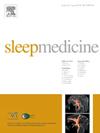客观睡眠持续时间、连续性和主观睡眠感知结构的作用:一项利用心率变异性推断客观睡眠指标的密集纵向研究的结果
IF 3.8
2区 医学
Q1 CLINICAL NEUROLOGY
引用次数: 0
摘要
本研究采用连续14晚的密集纵向设计,调查了由心率变异性(HRV)得出的客观睡眠指标与年轻人睡眠感知之间的关系。样本包括178名年龄在18-29岁之间的参与者,他们来自两项独立的研究,他们通过每天的睡眠日记提供数据。使用多分辨率卷积神经网络模型,通过动态心电图测量心率变异性用于睡眠阶段分类。受试者内部分析显示,较长的总睡眠时间、较高的睡眠效率、较长的慢波睡眠和较长的快速眼动睡眠与较好的睡眠感知有关,而睡眠开始后较长的醒来时间与较差的睡眠感知有关。值得注意的是,在受试者之间水平上没有发现显著的关联。客观的睡眠指标解释了主体内水平的睡眠感知差异是主体间水平的近五倍。此外,性别以及基线测量的抑郁症状和失眠症状并没有缓和客观睡眠指标和睡眠感知之间的受试者内部关联。这些发现强调了充足的睡眠时间、睡眠结构质量和睡眠连续性对个人夜间睡眠感知的重要性。与传统的多导睡眠描记法相比,该研究使用了由心率波动引起的多个夜晚的睡眠分期,这代表了一种方法学上的优势,提供了详细的、侵入性较小的评估。此外,这些结果对于临床应用尤其重要,因为它们可以作为个性化干预改善睡眠感知的基础。本文章由计算机程序翻译,如有差异,请以英文原文为准。
The role of objective sleep duration, continuity, and architecture for subjective sleep perception: Findings from an intensive longitudinal study using heart-rate variability to infer objective sleep indicators
This study investigates the relationship between objective sleep indicators derived from heart rate variability (HRV) and sleep perception in young adults using an intensive longitudinal design over 14 consecutive nights. The sample included 178 participants aged 18–29 years from two separate studies, who provided data via daily sleep diaries. Using a multi-resolution convolutional neural network model, heart rate variability measured via ambulatory electrocardiography was used for sleep stage classification. Within-subject analyses revealed that longer total sleep time, higher sleep efficiency, more slow-wave sleep, and more rapid-eye-movement sleep were associated with better sleep perception, while longer wake after sleep onset was linked to poorer sleep perception. Notably, no significant associations were found on the between-subject level. The objective sleep indicators explained nearly five times as much variance in sleep perception at the within-subject level than at the between-subject level. Additionally, gender, as well as depressive symptoms and insomnia symptoms measured at baseline did not moderate the within-subject associations between objective sleep indicators and sleep perception. These findings underscore the importance of sufficient sleep duration, quality of sleep architecture, and sleep continuity for individuals' perceptions of their sleep on a nightly basis. The study's use of HRV-derived sleep staging over multiple nights represents a methodological strength, providing detailed and less intrusive assessment compared to traditional polysomnography. Furthermore, these results are particularly important for clinical applications, as they can be basis for individualized interventions to improve sleep perception.
求助全文
通过发布文献求助,成功后即可免费获取论文全文。
去求助
来源期刊

Sleep medicine
医学-临床神经学
CiteScore
8.40
自引率
6.20%
发文量
1060
审稿时长
49 days
期刊介绍:
Sleep Medicine aims to be a journal no one involved in clinical sleep medicine can do without.
A journal primarily focussing on the human aspects of sleep, integrating the various disciplines that are involved in sleep medicine: neurology, clinical neurophysiology, internal medicine (particularly pulmonology and cardiology), psychology, psychiatry, sleep technology, pediatrics, neurosurgery, otorhinolaryngology, and dentistry.
The journal publishes the following types of articles: Reviews (also intended as a way to bridge the gap between basic sleep research and clinical relevance); Original Research Articles; Full-length articles; Brief communications; Controversies; Case reports; Letters to the Editor; Journal search and commentaries; Book reviews; Meeting announcements; Listing of relevant organisations plus web sites.
 求助内容:
求助内容: 应助结果提醒方式:
应助结果提醒方式:


